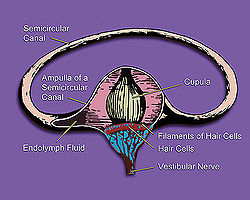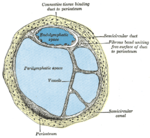- Semicircular canal
-
Semicircular canal 
Exterior of labyrinth. 
Inner ear illustration showing semicircular canal, hair cells, ampulla, cupula, vestibular nerve, & fluid Latin canalis semicircularis Gray's subject #232 1049 Artery stylomastoid artery MeSH Semicircular+Canals A semicircular canal is one of three semicircular, interconnected tubes located inside each ear. The three canals are the horizontal semicircular canal (also known as the lateral semicircular canal), superior semicircular canal (also known as the anterior semicircular canal), and the posterior semicircular canal.
The canals are aligned approximately orthogonally to one another. The horizontal canal is aligned roughly horizontally in the head. The superior and posterior canals are aligned roughly at a 45-degree angle to a vertical plane drawn from the nose to the back of the skull. [1] Thus, the horizontal canal detects horizontal head movements (such as when doing a pirouette), while the superior and posterior canals detect vertical head movements.
Each canal is filled with a fluid called endolymph and contains a motion sensor with little hairs (cilia) whose ends are embedded in a gelatinous structure called the cupula. As the skull twists in any direction, the endolymph is thrown into different sections of the canals. The cilia detect when the endolymph rushes past, and a signal is then sent to the brain.
The semicircular canals are a component of the bony labyrinth.
Among species of mammals, the size of the semicircular canals is correlated with their type of locomotion. Specifically, species that are agile and have fast, jerky locomotion have larger canals relative to their body size than those that move more cautiously.[2]
Additional images
Transverse section of a human semicircular canal and ductIllustration of otolith organsSemicircular canals on skull X-rayReferences
- ^ Orientation of Human Semicircular Canals Measured by Three-Dimensional Multiplanar CT Reconstruction, Journal of the Association for Research in Otolaryngology, 6 (3), 2005.
- ^ Spoor, F.; T. Garland, Jr., G. Krovitz, T. M. Ryan, M. T. Silcox, and A. Walker (2007). "The primate semicircular canal system and locomotion". Proceedings of the National Academy of Science U.S.A. 104 (26): 10808–10812. doi:10.1073/pnas.0704250104. PMC 1892787. PMID 17576932. http://www.biology.ucr.edu/people/faculty/Garland/Spoor_et_al_2007.pdf.
Categories:- Ear
- Sensory organs
- Vestibular system
- Head and neck
Wikimedia Foundation. 2010.



